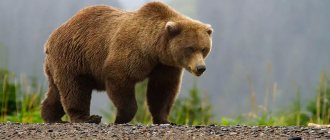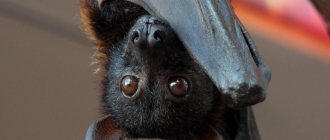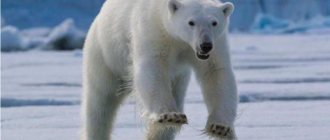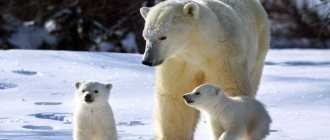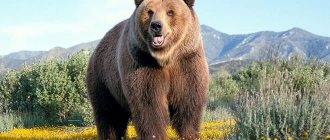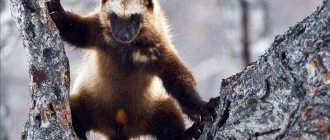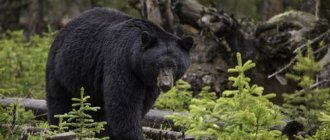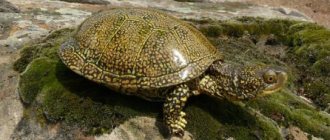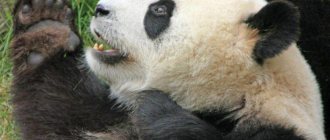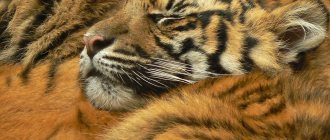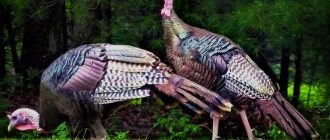A little about the characteristics of polar bears
It is believed that the polar bear evolved from the grizzly bear approximately 500 thousand years ago. Now this is the largest species of bear, and its closest relative is the brown bear.
The polar bear is found in northern Russia, in Alaska, Greenland, Canada, and the Spitsbergen archipelago and its number is about 25 thousand individuals.
Ongoing climate change, in particular rising temperatures, and pollution of ocean waters can lead to a significant reduction in their number. According to scientists, if nothing changes, by the middle of the century there will be only a third of the current number of polar bears left.
The height of adult individuals at the withers reaches 1-1.5 m, the length of the body is up to 3 m; the weight of males is 350-545 kg, the weight of females is up to 295 kg.
Reference! Under natural conditions, a polar bear lives 15-18 years, and when kept in captivity - about 30 years.
The body of polar inhabitants is maximally adapted to year-round cold, and nature has tried to make their existence easier. They are helped to endure frosts by a thick layer of fat under the skin from 5 to 10 cm thick (it retains heat well), a thick undercoat, the ability of the upper layer of fur to repel water, a small surface of the ears and tail, which contributes to low heat loss.
The surface of the ice is uneven, hard, and the bear has special adaptations to move on it: fur on the feet and hard tubercles on the sole. Thanks to this, bears run quickly on smooth ice and hard snow, accelerating up to 40 km/h. Longer front legs also contribute to faster running.
Just as on land, the bear feels free in the water and spends a lot of time there in search of food. Webbed paws and a layer of fat under the skin help them stay on the water for a long time and swim at high speeds - up to 10 km/h.
Food for him must be fatty and high-calorie in order to replenish energy costs. A keen sense of smell picks up the smell of animals at a great distance from them, and the color of the fur, merging with the terrain, and natural agility allow you to unnoticed get close to the prey: ringed seal, bearded seal, seal, seal.
A polar bear's metabolism slows down if it has not eaten for about 10 days. This unique feature was given by nature for a reason - it helps to survive in times of famine.
During the entire period of her life, the female gives birth to small offspring - up to five cubs. Pregnancy lasts 8 months, birth occurs in November-January, and by March-April the mother bear and her cubs leave the den. The male does not make a den for himself because he does not hibernate.
Despite the large size of the female, the cubs are born small - 30-35 cm in length and weighing up to 500 g. They grow very quickly, but still stay with their mother for a long time - up to 2.5 years.
Amazing facts about the polar bear:
- the largest weight of an individual recorded at this time was 1000 kg;
- a bear cub is born on land, but in the scientific community polar bears are called sea bears because of their ability to spend a long time in water;
- A clean animal spends up to half an hour after eating to clean itself up;
- a large amount of blood flows to the tongue, so strong pigmentation is observed on it, it even happens that it acquires a bluish tint;
- during a fast run, the bear’s body can overheat even in frost below 45 °C; under normal conditions, its temperature does not exceed 31 °C;
- A bear can smell seals in water 1 km away, and on the ice surface 30 km away;
- the hunt goes well for him in only 2% of cases;
- during the period when the female is in the den with the cub, she goes for several months without food, water, or defecates, for fear of leaving him unprotected;
- northern peoples treat the polar bear with great respect and, after hunting it, give it various household items and tools as gifts;
- The liver of a polar bear contains a large amount of vitamin A - in a 100-gram piece it is five hundred times more than a person’s daily requirement, and such an excess is dangerous to health, so it is not used for cooking.
Where do they live?
Polar bears live in northern Russia, Alaska, Canada, Greenland and the Spitsbergen archipelago, Norway. They live on sea ice where they have easy access to open water to hunt seals. Part of the year is spent on solid ground.
Security status:
vulnerable
Biologists estimate that there are between 20 and 25 thousand polar bears living in the wild. At a meeting of polar bear experts in 2009, experts reported that of 19 subpopulations, 8 were in severe decline, 3 were stable, and just 1 was increasing. Data on the remaining 7 populations do not allow us to determine their status.
Research shows that melting Arctic ice due to global warming could lead to two-thirds of polar bears becoming extinct by 2050. Bears also suffer due to oil development and pollution.
In May 2008, the United States announced the inclusion of the polar bear in the Red Book as an endangered species, and Canada and Russia as a vulnerable species.
Interesting and unusual things about the polar bear
The world community, interested in preserving and increasing the animal world on Earth, is trying to draw attention to the small species of polar bears in order to preserve its population. The calendar even has a date dedicated to the unique animal - International Polar Bear Day is celebrated on February 27.
Let's tell you some amazing and interesting facts about him.
Why do polar bears have white fur?
The true color of a polar inhabitant's skin is shown by his nose - it is as black as the skin under the fur. Fur color is an amazing and unusual feature of a polar inhabitant who has adapted to living conditions in eternal snow.
The fur hairs (5-15 cm long) that are visible to us and the short undercoat are actually colorless, almost transparent. Each guard hair, hollow inside, contains a pocket filled with air, and sunlight, reflected from it, appears white.
The scattering of light is also facilitated by salt particles that accumulate on hairs while in salt water, and the keratin substance contained in them. Keratin protein molecules appear whitish in the light, which also gives the fur a white color.
An amazing fact: fur color can vary depending on the environment. In the summer, when there is a lot of sun and the bear swims a lot, the fur acquires a yellowish tint, and in the fall new fur grows and it is snow-white. Those individuals that live far from water and swim less often have whiter fur than those that spend a lot of time in the water.
Interesting! The fur color of polar bears that live on land or spend a lot of time there becomes light brown, while those living in zoos sometimes turn green. The green color is given by algae that have entered the cavity of the villi and begun to multiply there quickly.
Amazing endurance
The need to look for food in the silent desert snows made the polar bear very strong and resilient.
The webbed paws are very large and cut through thick water like powerful blades, making it possible to reach speeds of up to 10 km/h. For comparison, the speed of world champion swimmers reaches only 7 km/h!
According to observations, a bear can swim, without rest, to cover a distance of 100 km. There have been cases when it was seen in the middle of the ocean about 321 km from the nearest shore.
But for now, the official record remains with the bear, who swam about 680 km. The she-bear and her cub went to look for a new place to live, because where she lived, active melting of the ice began, and their inhabitants moved to another place. There was nothing to eat and we had to look for better conditions. The bear cub did not survive the long journey, and after 9 days the bear reached land, having lost a fifth of her body weight. This unusual fact speaks of the unique endurance and strength of polar bears, and the amazing capabilities of representatives of the animal world.
Polar bear cannibalism
Due to their living conditions, polar bears feed on animals living in similar conditions. But in recent decades, significant climate changes have occurred and, accordingly, conditions in the North are changing - sea ice is melting more intensely, which reduces the space for hunting.
If possible, bears go to land and hunt there, but it happens that some individuals begin to eat their own kind.
Science knows cases of females eating their cubs when they are sick and weak, but recently cannibalism has been observed among adults, when an adult bear can eat a young one if they are in a hopeless situation, for example, in a trap on land.
Such cases were noted in Canada (2009), near the shores of Spitsbergen (2012).
Infrared camera doesn't see polar bear
There are many devices for observing animals: cameras, video cameras, sound detectors, navigators, etc. It is difficult to observe a polar bear - the spaces are huge, you won’t sit in ambush - it’s cold, you can’t leave the equipment in the cold for a long time - it will fail, so scientists decided to conduct experiment and use an infrared camera.
An amazing fact, but apart from noses, eyes and steam from the bears’ breath, they saw nothing else. Later, studies were carried out and it turned out that a camera with infrared rays “sees” not only the heat emanating from the animal, but also catches the radiation emanating from it.
It was concluded that the bear’s fur has radio-emitting properties, just like the surface of the snow, so the camera simply “does not notice” the polar bear.
Grizzly-polar bear hybrid
Scientists not so long ago, in 2006, discovered an interesting fact about the polar bear - an appearance that is unusual for the species. A hunter noticed this after the hunt and informed them about what he saw. The research results showed that this individual has characteristics of both a polar bear and a grizzly bear.
Such mixing of species has been observed when kept together in captivity, but this is the first recorded case in the wild.
Reference! As of 2010, there were 17 individuals - hybrids of polar bears and grizzlies.
Later, a descendant of a hybrid and a grizzly bear was discovered, after which scientists came to the conclusion that it is possible to obtain offspring by crossing different species of bears.
Unusual hybrid bears began to be called grolars, polar grizzlies, nanulaks (Nanuk + Aklak - polar bear + grizzly bear). Their appearance is similar to the appearance of both species - the elongated neck and tail are from a polar bear, the head, paws, and shoulder part are from a grizzly bear, and the fur is something in between the fur of both species.
Hybrids, of course, have it more difficult - their paws are less adapted for swimming, and they cannot stay in water for a long time, nor can they walk on smooth ice.
Appearance
The polar bear is the largest representative of the bear family and the order of carnivores. Its length reaches 3 m, weight up to 1 ton. Usually males weigh 450-500 kg, body length 200-250 cm. Females are noticeably smaller (200-300 kg, 160-250 cm). Height at the withers is 130-150 cm. The smallest bears are found in Spitsbergen, the largest in the Bering Sea.
The polar bear is distinguished from other bears by its long neck and flat head. His skin is black. The color of the fur coat varies from white to yellowish; In summer, the fur may turn yellow due to constant exposure to sunlight. The polar bear's fur is devoid of pigment color, and the hairs are hollow. Translucent hairs allow only ultraviolet rays to pass through, giving the wool thermal insulation properties.
In ultraviolet photography, a polar bear appears dark. Due to the structure of the hairs, a polar bear can sometimes turn green. This happens in hot climates (in zoos), when microscopic algae grow inside the hairs.
The soles of the feet are lined with wool to prevent slipping on ice and freezing. There is a swimming membrane between the toes, and the front part of the paws is lined with stiff bristles. Large claws can hold even strong prey.
They really love seals
Polar bears spend about half of their time hunting, and seals are their main food source. In particular, they look for ringed seals and bearded seals because they contain a lot of fat, and fat is critical to the polar bear's survival. They hunt by looking for areas of cracked ice and waiting for seals to surface. They use their sense of smell to find them and often wait for hours or days. According to WWF, less than 2% of their hunts are actually successful. (, )
That's why they also collect whale carcasses and look for other food sources such as bird eggs and walruses, the National Wildlife Federation says. They are at the top of the Arctic food chain and have no predators other than humans and other polar bears. ()
Complex Observations
Since the spaces in the Arctic are vast and the temperatures are low, it is very difficult for humans to constantly monitor polar bears, so they do this with the help of video cameras, navigators, sound detectors and other devices. But sometimes devices also fail in the cold.
One day they decided to conduct an experimental study using an infrared camera. When viewing the footage, only the nose, mouth, eyes and steam from the air exhaled by the bears were visible, but he himself was not visible. The fact is interesting, and at first it was not clear why this happened, but later the reason was found.
It turned out that the thick subcutaneous layer of fat and hair create an obstacle to infrared rays and, in addition, the background radiation of snow and ice coincides with the background radiation of the animal. That is why it is not visible in infrared light.
They are classified as marine mammals
Because polar bears depend on the ocean for food and icy habitat, they are the only species of bear considered to be marine mammals. This means they are grouped with seals, sea lions, walruses, whales and dolphins, and are also covered by the Marine Mammal Protection Act. The law, signed in 1972, prohibits the “take” or import of any marine mammal (in this context, “take” means to pursue, hunt, catch or kill). ()
They have many names
Scientifically, the polar bear is known as Ursus maritimus, but throughout the world this species has many interesting nicknames, such as polar bear, northern bear, sea bear, oshkuy, nanuk (for the Inuit), isbjorn (for the Swedes) and umka. Scandinavian poets called the bear the "white sea stag", the "terror of the seal", the "rider of the icebergs", the "curse of the whale" and the "sailor on the ice floe". They said the bear had the strength of a dozen men and the wit of 11 men. The Sami, or indigenous people of Northern Europe, called bears “dogs of God” or “old men in fur coats.” They refused to call them polar bears for fear of offending them. ()
